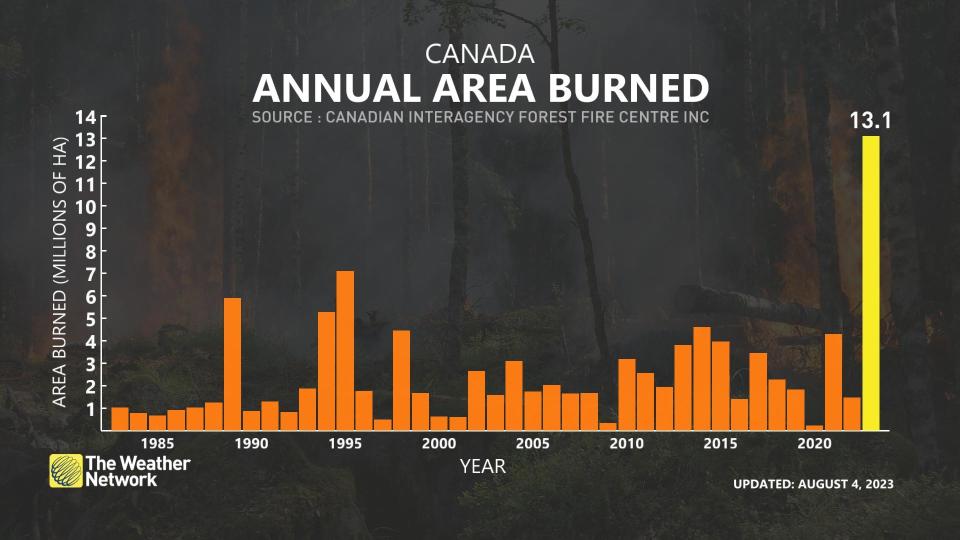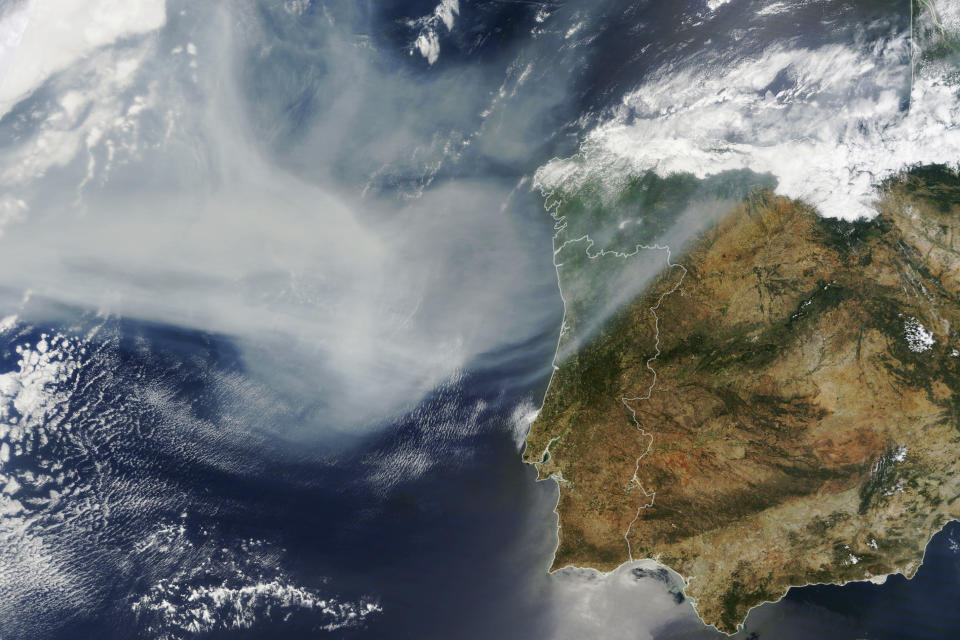Canada’s hot, fiery summer generating historic smoke emissions
Every year of late seems to break a laundry list of all-time records. 2020 saw the most hurricanes ever recorded in the Atlantic. 2021 saw Canada’s hottest temperature ever measured, followed a few months later by British Columbia’s most destructive floods in history.
2023 is no exception. Numerous record-breaking heat waves and unprecedented oceanic heat will secure 2023’s place in the record books. The surplus of heat in recent months plunged Canada into its worst wildfire season on record, fuelled in large part by the historic fires raging throughout Western Canada.
Now, the months-long string of intense fires have set another grim milestone: The most wildfire smoke emissions ever recorded in a single year.
DON’T MISS: How have emissions contributed to the current heat records?
Canada’s fires account for a quarter of the world’s fire carbon emissions in 2023
The Copernicus Atmosphere Monitoring Service (CAMS) announced last Thursday that Canada’s wildfire smoke emissions so far in 2023 have more than doubled the previous all-time record set back in 2014 -- and we’re only eight months into the year.

Data collected by CAMS, an international and intergovernmental agency operating in the European Union, revealed that this year’s wildfires raging throughout Canada have released 290 megatonnes of carbon emissions through August 1.
This stunning year-to-date measurement more than doubles the previous annual record of 138 megatonnes set in 2014, according to the agency. CAMS began measuring carbon emissions produced by fires in 2003.
While significant wildfires have raged throughout the world in recent months, including Greece and Russia, CAMS revealed that Canada’s fires are responsible for more than one-quarter of the world’s total fire carbon emissions so far this year.
WATCH: What role does climate change truly play in wildfires?
Provincial records add up to a mammoth national fire season
We’re just past halfway through the summer and this is already the most destructive wildfire season on record across Canada. Officials have measured just over 13,000,000 hectares of land consumed by wildfires throughout the country through Aug. 5. This far exceeds the previous yearly high of 7,105,998 hectares burned countrywide in 1995.
Nearly 40 per cent of all the land burned across Canada this year was consumed in the raging fires that struck northern Quebec in May and June. Quebec’s fires consumed more than 5.1 million hectares of land, an expanse of real estate that nearly equals the size of Nova Scotia.
Nova Scotia itself has seen its share of wildfires this year, as well. The province battled its largest wildfire on record in early June when a blaze in Shelburne County, about 200 km southwest of Halifax, grew to consume 23,525 hectares and took two full months for crews to fully extinguish.

RELATED: How climate change ‘loads the dice’ for severe wildfire seasons in Canada
The historic fire was one of several large fires across the province that destroyed hundreds of homes and displaced tens of thousands of people at the height of the evacuations.
Out west, both British Columbia and Alberta have both seen their worst wildfire seasons on record in terms of land burned. Alberta smashed its 42-year-old record of 1.36 million hectares burned by fires, and B.C. exceeded its old record of 1.35 million hectares.
By Aug. 5, Alberta had 1.84 million hectares of land consumed by blazes, while B.C.’s total stood at 1.56 million hectares of burned land.
Fire activity across the territories up north significantly ticked up through July and into August. Blazing heat through July set the stage for raging infernos to grow throughout the Far North. Fort Good Hope, N.W.T., recorded the Far North’s hottest temperature ever measured with a high of 37.4°C on July 8.
Dry conditions and persistent heat allowed blazes to spark throughout the Northwest Territories, consuming more than 1.8 million hectares of land through Aug. 5. One particularly intense fire forced officials to set up sprinklers outside of Yellowknife, as the blaze threatened to cut off the only road linking the capital with the rest of the territory.
Thick smoke has caused extensive issues this year
Northern Quebec’s intense fires resulted in prolific smoke choking vast swaths of Canada and the United States, bringing historically bad air quality to tens of millions of people in the Greater Toronto Area, New York City and Washington, D.C.,.

Wildfire smoke from blazes burning throughout Canada reached the Iberian Peninsula in late June 2023. (Image courtesy of NASA.)
The smoke from Quebec’s fires even crossed the Atlantic to darken the skies over western Europe.
While the smoke flowing from northern Quebec was the primary culprit behind some of this season’s worst air quality, thick smoke from the fires burning throughout Western Canada and the territories have contributed to the vast plumes of air pollution trekking across the country and south of the border this season. The air quality in Yellowknife was unhealthy or hazardous for much of July due to fires in the region.
Header image courtesy of NASA Earth Observatory.

